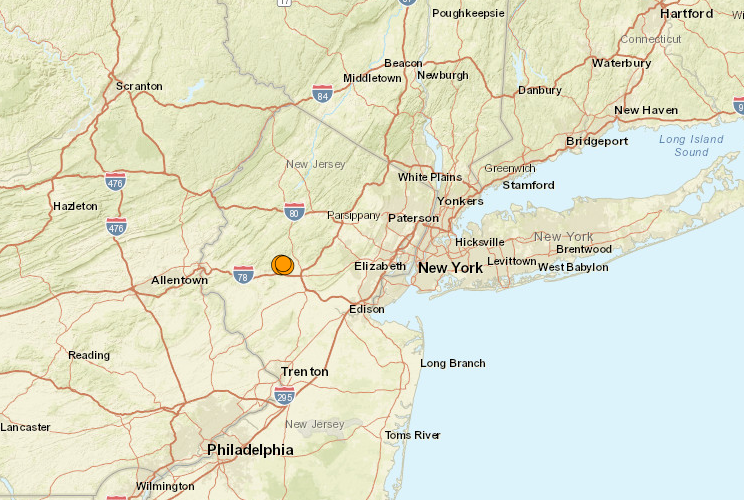A rare 4.8 magnitude earthquake rattled buildings across parts of the Northeast on Friday morning, according to the US Geological Survey (USGS), with tremors felt from Washington, DC to New York City to Maine. The quake, which was the third largest recorded in the area in the last five decades and the strongest in New Jersey in more than 240 years, was followed by over 20 aftershocks, including a 4.0 magnitude tremor that hit 37 miles west of New York City around 6 p.m.
Millions of people across hundreds of miles felt the initial quake, which disrupted work and school life and jolted nerves momentarily before an early spring day seemed to return to normal. In a region unaccustomed to earthquakes, stunned residents described initially thinking of a passing tractor trailer or freight train before realizing it was something more.
"At first I thought it was a big truck driving down a nearby road or the oil burner shaking inside my house," said Jeanne Evola, who described her whole house shaking in Franklin Square on Long Island. She ran outside as the quake intensified, finding her neighbors describing the same rattling sensation.
With authorities reporting little or no damage and minimal travel disruptions, people soon resumed their everyday lives. The New York Police Department said there were no damages or injuries reported, and New York Mayor Eric Adams urged New Yorkers to "go about their normal day" at a news briefing later Friday.
However, the quake did trigger some evacuations and infrastructure inspections. In Newark, New Jersey, three neighboring homes were evacuated after residents reported structural damage, according to the city's public safety director, Fritz Fragé. No injuries were reported, but firefighters responded to calls about structural damage in the three buildings, more than 30 miles from where the quake originated. Ten families - 25 adults and three children - were relocated.
In Pennsylvania, the Philadelphia Police Department received more than 200 calls "in a very short period of 20 minutes" after the quake, according to Commissioner Kevin J. Bethel. The calls overloaded the system, but the department was able to get the call base back down within 30 minutes.
The earthquake also affected some air and train travel in the Northeast. Flights to the New York Kennedy, Philadelphia, Baltimore, and Newark airports were initially held, according to the Federal Aviation Administration. The air traffic control tower at Newark Liberty airport was evacuated, and runways were inspected for damage. Amtrak reported that train service was slowed after the earthquake so track inspections could be performed.
The USGS said a number of factors influenced the amount of places where the quake was felt, including the geology of the region itself. The earthquake was on the extreme end of what the USGS considers a shallow earthquake, just below the surface at 5 km depth, which made it easier for residents in affected areas to feel the shaking.
As of 2 a.m. on April 6, the USGS website reported over 20 aftershocks since the initial earthquake, ranging in magnitude from 1.5 to 4.0. The agency's aftershock forecast predicted a 36% chance of aftershocks at a 3.0 magnitude or higher, an 8% chance of aftershocks at a 4.0 magnitude or higher, and a 1% chance for aftershocks at a magnitude of 5.0 or higher over the next week.
USGS scientists encouraged people to fill out the "Did You Feel It?" reports on their website, which they described as a critical citizen science project in building knowledge around earthquakes, especially in a region where they're less common. By midafternoon on Friday, the agency had received more than 161,000 reports and extrapolated that the quake had been felt by millions of people.
As the Northeast grapples with the aftermath of this rare seismic event, residents are urged to stay informed, follow the guidance of local authorities, and take steps to prepare for potential future earthquakes. While the region may not be accustomed to such occurrences, the recent quake serves as a reminder that no area is entirely immune to the power of nature.






